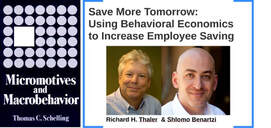
In discussing the implications for policy, Schelling argued that “getting ‘over the hump’ from one stable equilibrium to another requires either a large perturbation or concerted action”. Quotas are one such concerted action. The Rooney Rule specifies a quota of interview candidates for NFL Head Coaching positions. Maybe the quotas need to be on the number of actual Head Coaches.
Schelling’s analysis started with a checkerboard model and specified preferences. He traced the logical implication from micro motives to macro outcomes. The wonders of economic theory and thought experiments.
Aggregating micro preferences into macro outcomes can be complicated. The system of aggregation plays a big role. Consider the situation where 100 commentators are asked to predict the outcome of the Super Bowl. (Or collect the predictions from before the Bengals-Chiefs game.) The sum of individual predictions could give a distorted picture. If each of the 100 commentators believes that the Rams have a 55% chance of winning the Super Bowl then all 100 will pick the Rams. Looking at the macro picture one would see a “certainty” with 100/100 votes for the Rams.
Could a similar aggregation method be producing the outcome we see at the level of NFL Head Coaches? Each team gets to pick only one Head Coach at a time.
How might a quota work given the dynamics of NFL firing and hiring? At one stage last month there were eight vacancies. If we were in a happy equilibrium, like Schelling’s coins before the “shock”, then we could require similar replacements to those being replaced. Allow the owners of the eight NFL teams get together and agree the hires between them. If they could not agree then get them to select a panel of eight coaches from which their next hire would be determined by lottery.
Unfortunately, the current situation does not seem to be a happy one. How might the transition to such a happy equilibrium happen? Here we might use the thinking behind the “Save More Tomorrow” concept. That idea arose where individuals said that they were not saving enough but that they could not make savings at the moment. These individuals signed up to a commitment to save a greater proportion of any income increase that they would receive in the future. Back to our eight vacant NFL positions. In the transition period, a greater proportion of these could be designated for minority candidates. Again, the NFL owners could sort it out between themselves in the shadow of the lottery system.
Schelling used coins on a game board to educate us on how individual decisions can lead to less desirable collective outcomes. He noted that our preferences could be driven by conscious or unconscious desires. Our school football coach also used coins to educate his players. He would put coins on a green cloth. The green surface had the markings of a GAA field on one side. The coach had made these markings. On the other side were the original markings of a soccer field. He used the coins to illustrate the decisions we should be making in given scenarios. His words were all reason and rationalization. However, he used the coins to feed our unconscious biases. We were always the bigger, more valuable, silver coins. Sometimes the unconscious can have a bigger impact unless explicitly guarded against. Therefore, a conscious commitment by the NFL to a quota for hires rather than interviews might be a good idea.
 RSS Feed
RSS Feed